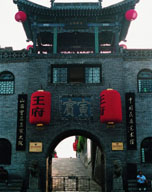 The Wang Family Residence is located in the northernmost part of Jingsheng Village in Lingshi County, Shanxi Province. It is 150 kilometers south of Taiyuan, capital of Shanxi, and 12 kilometers from the county seat. Facing south and occupying a higher ground, the compound overlooks a vast horizon.
The Wang Family Residence is located in the northernmost part of Jingsheng Village in Lingshi County, Shanxi Province. It is 150 kilometers south of Taiyuan, capital of Shanxi, and 12 kilometers from the county seat. Facing south and occupying a higher ground, the compound overlooks a vast horizon.
According to historical documents, a young man named Wang Shi moved to Jingsheng in 1313. After settling down, he not only farmed, but also sold tofu to make a living. In the following generations, Wang's descendants who started off as farmers became merchants and then officials. As the family's finance and prestige increased, it carried out extensive building work, creating a great compound of residential houses that is reputed to be the Number One Residence in China.
The Wang Family Residence, made up of the East Compound, the West Compound, and the Xiaoyi Ancestral Temple, covers a total area of 34,650 square meters. The residence as a whole features a functional layout and a distinctive design. Wood, brick, and stone carvings can be found everywhere. Exquisite designs and fine craftsmanship are showcased in almost everything from eaves to screen walls to stone bases, door-knockers, shrines, doors, windows, and dougong (wooden square blocks inserted between the top of a column and a crossbeam). The mansion integrates the imposing manner of North China's architecture and the elegant and graceful style of the structures in South China. Paintings of humans, flowers, and animals as well as calligraphic works of poems decorate the houses. Standing out from the many residences in Shanxi Province, the Wang Family Residence is regarded as a museum of architectural art.
The construction of the East Compound started in 1796 and lasted 16 years. With 218 rooms in 26 courtyards, rising one upon another according to the gradations of the mountain, the compound faces the water. Smaller courtyards are enclosed by larger ones, forming four circles in all. Each of the circles is surrounded by high walls. The main structures are symmetrically laid out along an axis. Halls, towers, and pavilions are built in accordance with the geographical conditions. Study courtyards, gardens, and kitchen courtyards compliment one another brilliantly.
Stepping into the Wang Family Residence, you feel as if you have entered a maze or an arena of culture and art. The strong sense of Confucianism permeates the compound, leading visitors into a lofty spiritual realm.
In 1997, the East Compound opened to the public and was honored with the title the Museum of the Chinese Art of Residence. To date, it has received thousands upon thousands of visitors from home and abroad.
(China Pictorial December 10, 2002)
|

